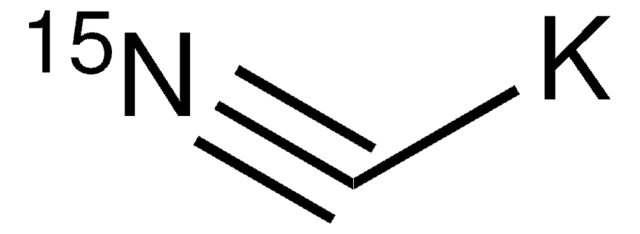1.06437
Sodium cyanide
EMPLURA®
Synonym(s):
Sodium cyanide
About This Item
Quality Level
product line
EMPLURA®
Assay
≥95.0% (silver nitrate titration)
form
solid
potency
4.7 mg/kg LD50, oral (Rat)
7.7 mg/kg LD50, skin (Rabbit)
pH
11.7 (20 °C, 100 g/L in H2O)
bp
1496 °C/1013 hPa
mp
563 °C
solubility
370 g/L
density
1.6 g/cm3 at 20 °C
bulk density
750‑900 kg/m3
anion traces
chloride (Cl-): ≤0.05%
hexacyanoferrate(II) ([Fe(CN)6]4-): ≤0.05%
sulfide (S2-): ≤0.02%
cation traces
Pb: ≤0.005%
storage temp.
no temp limit
InChI
1S/CN.Na/c1-2;/q-1;+1
InChI key
MNWBNISUBARLIT-UHFFFAOYSA-N
Application
- Green Synthesis of Sodium Cyanide Using Hydrogen Cyanide Extracted under Vacuum from Cassava (Manihot esculenta Crantz) Leaves.: This study presents an innovative green approach to synthesizing sodium cyanide using hydrogen cyanide extracted from cassava leaves. The process involves maceration and vacuum extraction, producing NaCN with potential applications in environmentally friendly chemical synthesis and analytical methods (Monga et al., 2022).
Analysis Note
Identity: passes test
Chloride (Cl): ≤ 0.05 %
Hexacyanoferrate: ≤ 0.05 %
Sulphide (S): ≤ 0.02 %
Pb (Lead): ≤ 0.005 %
Legal Information
Signal Word
Danger
Hazard Statements
Precautionary Statements
Hazard Classifications
Acute Tox. 1 Dermal - Acute Tox. 1 Inhalation - Acute Tox. 1 Oral - Aquatic Acute 1 - Aquatic Chronic 1 - Eye Dam. 1 - Met. Corr. 1 - Skin Corr. 1 - STOT RE 1
Target Organs
Thyroid
Supplementary Hazards
Storage Class Code
6.1B - Non-combustible, acute toxic Cat. 1 and 2 / very toxic hazardous materials
WGK
WGK 3
Certificates of Analysis (COA)
Search for Certificates of Analysis (COA) by entering the products Lot/Batch Number. Lot and Batch Numbers can be found on a product’s label following the words ‘Lot’ or ‘Batch’.
Already Own This Product?
Find documentation for the products that you have recently purchased in the Document Library.
Customers Also Viewed
Our team of scientists has experience in all areas of research including Life Science, Material Science, Chemical Synthesis, Chromatography, Analytical and many others.
Contact Technical Service




